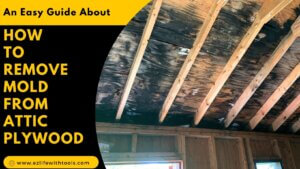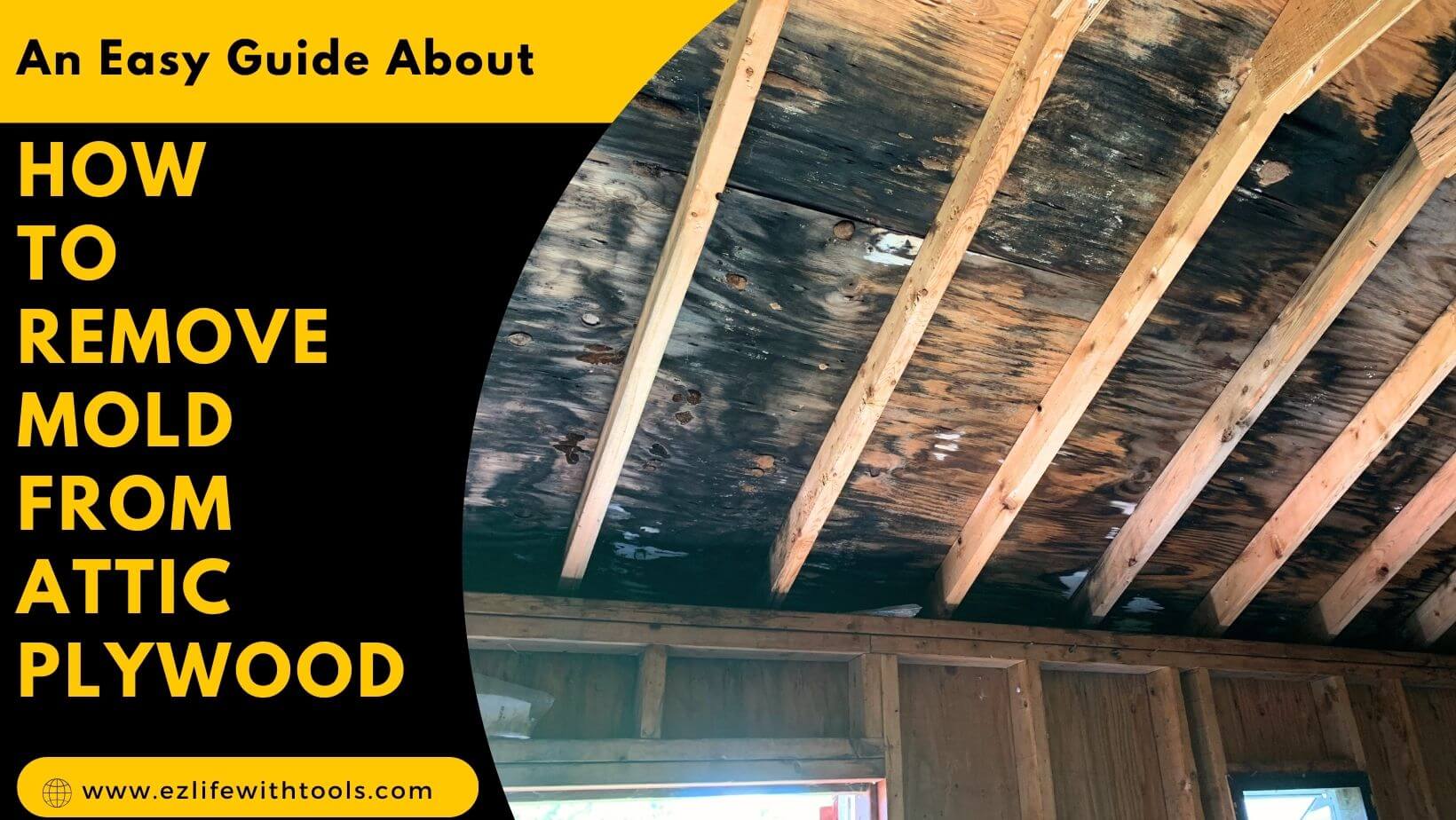Easy Guide: How to Remove Mold from Attic Plywood Safely

Mold growth in the attic is a common issue, and it not only damages the structural integrity of our attic but also poses health risks to occupants.
However, do not worry about it. Because only replacing or burning the plywood is not the solution.
We can remove Mold from attic plywood with the right knowledge and technique at the right time.
Today, I will describe all the signs and causes of Mold and its solutions to remove Mold.
So, keep reading, and you will learn all the steps.
What is Mold on Attic Plywood?
Mold is a type of fungus available in different colors, and it works in the natural environment by breaking down organic matter. It belongs to a diverse group of microorganisms.
We can see it both indoors and outdoors.
Mold produces tiny spores and releases them into the air, and when these spores land on a suitable surface with enough moisture and nutrients, they can grow and form new mold groups.
High humidity provides a suitable atmosphere for growing Mold on wood, paper, fabric, carpet, etc.
Causes of Growing Mold on Attic Plywood
Many reasons and factors are behind the growth of Mold on attic plywood. Here are some common causes.
Humidity / Moisture
One of the primary causes of Mold is the presence of high moisture in the air. High moisture provides a better environment for mold spores to germinate and grow. In this type of atmosphere, our plywood can be damaged, so immediately, we should treat them with a reasonable solution.
Improper Ventilation
Commonly, we construct residential and commercial buildings according to the construction rules. Proper ventilation is essential in attics to prevent moisture buildup. Sometimes, negligence can cause improper ventilation. It will raise the humidity level and grow Mold on the surface of the attic plywood.
Wrong Exhaust Systems
If the Bathroom and kitchen exhaust fans vent into the attic instead of outside, they will grow production of Mold.
Roof Leaks
It is a common cause of moisture in attics. If not immediately repaired, roof leaks can lead to persistent dampness, which grows the Mold on attic plywood.
Poorly Sealed Attic Access Points
Humid air can enter through Gaps or cracks around the attic, which causes moisture buildup on plywood surfaces and damages it.
Stored Items
Storing items in the attic without proper protection can trap moisture and contribute to mold growth on plywood surfaces and other materials.
Signs/Symptoms of Attic Plywood Mold
If we feel or see given symptoms on the surface of the attic plywood, it indicates the growth of Mold.
- A mildew smell.
- Black spots on the surface of wood or other discoloration
- Wet surface or water stains.
- Allergic Reactions like cough, sneezing, skin irritation.
- Frost on the roof sheathing during cold seasons.
- Bubbles appear on the surface of paint or wallpaper.
Note: If we suspect mold growth in our attic but cannot detect it visually, we will consult a professional mold testing and inspection services officer to confirm it.
Effects of Mold on Attic Plywood
While Mold plays a crucial role in the natural decomposition of organic matter, it can become a problem when it grows indoors. Below are described some effects.
Structural Damage
Mold can cause damage to the structural integrity of buildings.
Health Concerns
Mold can cause allergic reactions, respiratory problems, and other health issues in some individuals, especially those with mold allergies or asthma.
- Irritation of the skin, eyes
- Coughing
- Sneezing
- Nasal congestion
- Wheezing
- Running nose
- Sore throat
Unpleasant Odors
Mold growth often spreads a musty and unpleasant odor.
Cosmetic Issues
Mold growth on walls, ceilings, or other visible areas can create a bad image, and we need extra cleaning and remediation.
Types of Mold Removing Solutions
Several types of mold-removing solutions can be used on attic plywood. But it depends on our choice or severity of the Mold on plywood which solution we will apply.
Water and Detergent
It is a simple and effective solution to treat Mold with a mixture of a cleaning solution that we can create using water and a mild detergent, like dish soap or laundry detergent. It helps us to remove the Mold on the surface of the wood.
Vinegar
It is a natural and non-toxic solution we can use to kill and remove Mold. We will mix the same quantity of water and vinegar to create a cleaning solution. The acidic property of vinegar will break down the Mold and prevent it from returning.
Hydrogen Peroxide
It is a powerful and recommended chemical to kill the Mold on attic plywood. We don’t dilute it with water. We use 3% hydrogen peroxide directly on the affected surface. It is safer to use than bleach and does not produce harmful fumes.
Tea Tree Oil
It is a natural antifungal agent, and we can use it to remove Mold from attic plywood. We will mix only ten drops with a cup of water to produce a cleaning solution and spray on the mold-infested area.
Borax
Borax is a popular natural mineral-based solution used for mold removal for many years. It is a very strong solution to kill mold spores and prevent future growth. We will require a minimum quantity of it because we add one cup of borax in one gallon of water and apply it on the related surface or wood.
Commercial Mold Cleaners
If we want to avoid creating mold cleaning mixture at home, then we can buy specifically formulated mold cleaning products. There are various types of mixtures in the market. But always prefer to buy only EPA (Environmental Protection Agency) recommended products.
Gathering Necessary Tools to Remove Mold from Attic Plywood
We’ll need essential supplies to remove Mold from our attic plywood efficiently.
These include.
- Personal Protective Equipment Like KN95 mask, Plastic Gloves and goggles.
- Self-made or ready-made approved Cleaning Solution.
- Scrubbing Brushes to clean the mold-infested surface.
- Absorbent towels.
- Spray Bottle to apply the solution.
- Buckets to carry cleaning solution and collect mold-infested debris.
- Wet or Dry vacuum.
How to Remove Mold from Attic Plywood Step-by-Step
Mold removal is a crucial process for maintaining a healthy indoor environment.
Here’s a step-by-step guide on how to remove Mold.
- Before starting the mold removal process, we must ensure our safety precautions because I have already told you that it can cause allergic reactions and other health hazards.
- Inspect all areas where Mold is present because Mold can grow on various surfaces, like walls, ceilings, floors, and even within HVAC systems.
- Then, Seal off the affected area with a plastic sheet and tape to ensure that mold spores are not spreading to other parts of the home during the process.
- Set up proper ventilation using fans and opening windows to help dissipate mold spores and maintain fresh air circulation.
- Identify the source of moisture that led to mold growth. It can be a leaky pipe, roof, or poor ventilation. Addressing the moisture issue is essential to prevent future mold growth.
- Remove all the belongings stored in the attic that have been contaminated by Mold. In the future, these affected items can grow Mold again.
- Prepare a cleaning solution one of the above described, or a ready-made solution can be used.
- Using a scrubbing brush and the prepared cleaning solution, thoroughly scrub the mold-infested plywood.
- After cleaning, use absorbent towels to dry the surface. Properly ventilate the attic to ensure that the plywood dries completely. Moisture is Mold’s best friend, so that a dry environment will discourage its return.
Conclusion
In this comprehensive guide, I have described every step that can help successfully remove the Mold from your attic plywood. If you follow this article step-by-step, there is nothing to defeat in your mold-cleaning aim. Regular maintenance and preventive measures can prevent Mold from returning in the future.
Thank you for your precious time.
Best Wishes
Frequently Asked Questions
Can I remove mold from attic plywood myself?
Yes, you can remove it. But the important thing is that the protective gears must be used to clean or remove the mold. If the problem is extensive, consult a professional for a thorough diagnosis.
What are the required tools and materials to remove mold?
Commonly used tools are scrub brush, mold cleaner, protective clothing, and a mask. Materials may include dehumidifier and sealant for precautionary measures.
How can I prevent mold from returning after removal?
Find the root cause and fix it. Maintain a dry environment with adequate insulation and use mold resistant products for future prevention.
Can I paint over the mold on the attic plywood?
No, it is not recommended. First remove mold, then apply mold resistant primer or paint.
Can I use natural remedies to remove mold?
It can be effective for surface mold, but may not suitable for deeper problems. A professional grade mold cleaner is recommended for comprehensive removal.

